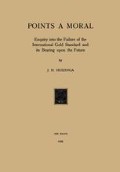Abstract
Among the countless explanations which different writers on post war monetary problems have drawn up to account for the failure of the gold flow mechanism there is one which recurs with remarkable regularity throughout practically the entire diversified literature on the subject. It is the opinion that America has seriously impeded the functioning of the international gold standard by its policy of gold sterilization; the United States are the villain of the piece with France a close second. As will be seen in the later pages of this chapter this view contains a considerable amount of truth. But in common with the overvaluation and rigidity theories offered in explanation of England’s abandonment of gold payments1), the sterilization theory suffers from overpopularization and in this way it has become blurred in outline. Easily comprehensible by the public at large, offering a convenient mould for the man in the street in which to form his understanding of current monetary affairs, these various popular explanations have lost in clarity what they have gained in popularity. The elements of truth which they contain and which properly presented would make for a better understanding of the difficulties with which the gold standard has had to battle, have not been tasted by a public opinion which has no time for careful mastication but must swallow its intellectual food wholesale. It is not a case for blaming anybody, not the financial editors of papers and periodicals who are forced by the swift flow of time to serve up their views of current economic events without the seasoning of careful thought, nor the public which equally pressed by the rush of affairs accepts them without close scrutiny.
We may well have reached the stage where an era of conscious and deliberate management must succeed the era of undirected natural evolution. Macmillan Report
Access this chapter
Tax calculation will be finalised at checkout
Purchases are for personal use only
Preview
Unable to display preview. Download preview PDF.
Bibliography
United States Treatises
W. R. Burgess (editor), Interpretations of Federal Reserve policy, 1930.
S. E. Harris, Twenty years of Federal Reserve policy, 1933.
H. L. Reed, Federal Reserve policy 1921–1930, 1930.
*J. H. Rogers, America weighs her gold, 1931.
Periodicals, Reports etc.
Annual Reports of the Federal Reserve Board. Federal Reserve Bulletins.
Report of the Committee on Recent Economic Changes, 1929.
Standard Statistical Bulletin; Basebook Issue 1930–1931.
Department of Commerce Studies on the International Balance of Payments of the U.S.
Rights and permissions
Copyright information
© 1935 Martinus Nijhoff, The Hague, Netherlands
About this chapter
Cite this chapter
Huizinga, J.H. (1935). America. In: Gold Points a Moral. Springer, Dordrecht. https://doi.org/10.1007/978-94-015-0657-1_3
Download citation
DOI: https://doi.org/10.1007/978-94-015-0657-1_3
Publisher Name: Springer, Dordrecht
Print ISBN: 978-94-015-0163-7
Online ISBN: 978-94-015-0657-1
eBook Packages: Springer Book Archive

